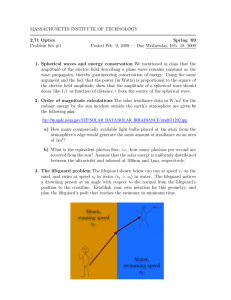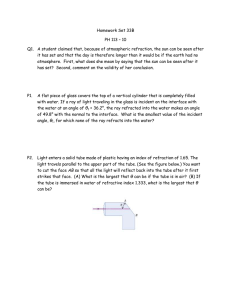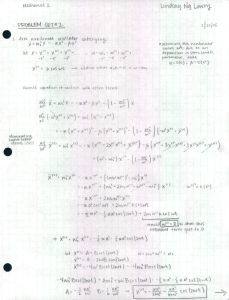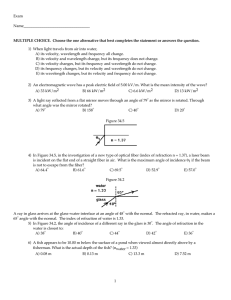MASSACHUSETTS INSTITUTE OF TECHNOLOGY 2.710 Optics Spring ’09 Problem Set #1
advertisement
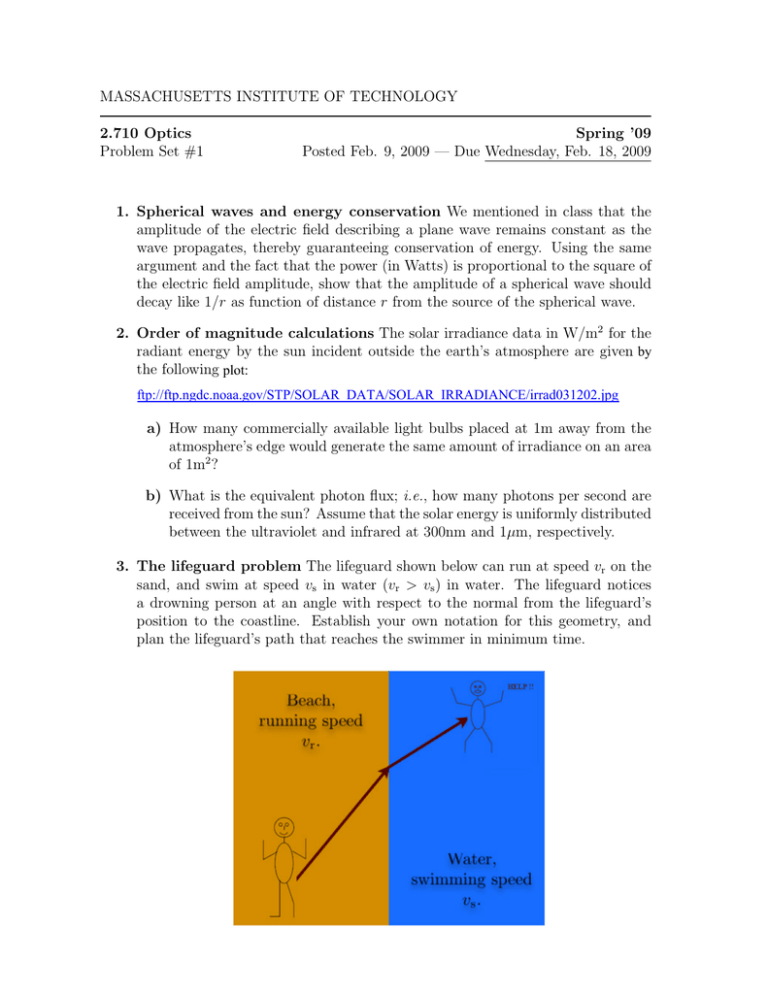
MASSACHUSETTS INSTITUTE OF TECHNOLOGY 2.710 Optics Problem Set #1 Spring ’09 Posted Feb. 9, 2009 — Due Wednesday, Feb. 18, 2009 1. Spherical waves and energy conservation We mentioned in class that the amplitude of the electric field describing a plane wave remains constant as the wave propagates, thereby guaranteeing conservation of energy. Using the same argument and the fact that the power (in Watts) is proportional to the square of the electric field amplitude, show that the amplitude of a spherical wave should decay like 1/r as function of distance r from the source of the spherical wave. 2. Order of magnitude calculations The solar irradiance data in W/m2 for the radiant energy by the sun incident outside the earth’s atmosphere are given by the following plot: ftp://ftp.ngdc.noaa.gov/STP/SOLAR_DATA/SOLAR_IRRADIANCE/irrad031202.jpg a) How many commercially available light bulbs placed at 1m away from the atmosphere’s edge would generate the same amount of irradiance on an area of 1m2 ? b) What is the equivalent photon flux; i.e., how many photons per second are received from the sun? Assume that the solar energy is uniformly distributed between the ultraviolet and infrared at 300nm and 1µm, respectively. 3. The lifeguard problem The lifeguard shown below can run at speed vr on the sand, and swim at speed vs in water (vr > vs ) in water. The lifeguard notices a drowning person at an angle with respect to the normal from the lifeguard’s position to the coastline. Establish your own notation for this geometry, and plan the lifeguard’s path that reaches the swimmer in minimum time. 4. Refraction from a dielectric stack A light ray is incident on a dielectric stack of refractive indexes as shown below at angle 76◦ with respect to the normal. What is the exit angle of the ray? n 7 =1.501 n 6 =1.514 n 5 =1.525 n 4 =1.534 n 3 =1.541 n 2 =1.546 n 1 =1.549 n 0 =1.550 760 5. Trapezoidal prism A light ray enters the trapezoidal glass prism shown below at angle θ with respect to the normal to the bottom surface. Derive a condition between the prism angle ψ, the glass index of refraction n, and θ such that TIR occurs at the 1st interface marked in the schematic. 1st TIR ψ θ glass refractive index n air n =1 6. Ellipsoidal refractor A plane wave (parallel ray bundle) is incident on an el­ lipsoidal refractor made of SF6 glass. The refractor has focal length f = 15mm at the nominal telecoms wavelength λ = 1.5µm. The incident ray direction is parallel to the major axis of the ellipsoid. Given the dispersion data n(λ) from the following website, http://refractiveindex.info/index.php?group=SCHOTT&material=SF6 a) Does the refractor focus perfectly at wavelengths other than the nominal? b) If your answer to the previous question is “yes,” then plot the focal length f (λ) for the near–infrared band 700nm ∼ 2.5µm. If your answer to the previous question is “no,” then plot a reasonable approximation for the focal length f (λ) for the near–infrared band 700nm ∼ 2.5µm. 2 MIT OpenCourseWare http://ocw.mit.edu 2.71 / 2.710 Optics Spring 2009 For information about citing these materials or our Terms of Use, visit: http://ocw.mit.edu/terms.
